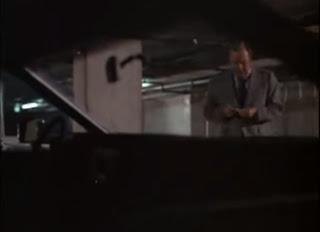Book Review: 'The Dakota Project' by Jack Beeching
‘The Dakota Project’ was published in hardcover in 1968; this Dell paperback (280 pp.) was issued in July 1971. The cover artwork is by Robert (Bob) Foster.
Foster illustrated many paperbacks in the 60s and 70s and used Steve Holland as a model, as the male figure on the cover of ‘Project’ reveals. Holland, of course, was the model for James Bama’s 'Doc Savage' covers for Bantam.
‘The Dakota Project’ is a first-person narrative on the part of a middle-aged British writer named Richard Conroy. As the novel opens, Conroy has arrived in North Dakota, where, logically enough, the Dakota Project is located.
Conroy is not overly impressed with the location of the project – a village surrounded by security fencing and mine fields, in the middle of the windswept prairie – but the vague thrill of working on a semi-clandestine endeavor, as well as a handsome salary, have induced him to sign on for a multi-year stint.
Conroy gets to work writing propaganda tracts, befriends a lesbian couple, and acquires a harelipped Mexican domestic (!) as a mistress. His superiors are pleased with his work, and as Fall turns to Winter, Conroy is promoted to the inner circle, where he learns of the Project’s true mission.
Conroy accepts this disclosure with some equanimity, reasoning that after his hitch is up, he can depart and re-enter civilian life without a backward glance. But when a high-ranking member of the Project recruits him for a possible coup, events start to lurch out of control.
Will Conroy side with the usurper and see his friends subjected to a dire fate ? Or will he rebel, and risk his life for a chance to escape the Project ?
Such a dilemma sounds like the ingredient for a good thriller, but unfortunately, ‘The Dakota Project’ is a dull and unimaginative read.
Author Beeching awkwardly tries to take the self-centered narrative peculiar to middle-aged white men, the same narrative that John Updike successfully mined with his ‘Rabbit’ novels, and meld it to a satirical thriller along the lines of ‘Dr Strangelove’.
Much of the novel is centered around long stretches of dialogue, in which the author shows to us his command of witty repartee. As well, there are plentiful monologues, during which Conroy muses about various frat-boy topics, such as how he best can get the lesbians into his bed, or how best to impress the Project directorship during administrative meetings.
The end result of these excursions into middle-aged male psychology is……… tedium.
‘The Dakota Project’ is unimpressive both as a near-future sf novel, and as a thriller. You’re better off passing on this title.













































































